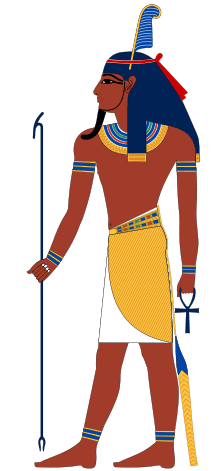Shu (Egyptian god)
| Shu | ||||||
|---|---|---|---|---|---|---|
| God of the wind and air | ||||||
 The ancient Egyptian god Shu is represented as a human with feathers on his head, as he is associated with light and air. This feather serves as the hieroglyphic sign for his name. Shu could also be represented as a lion, or with a more elaborate feathered headdress.[1] | ||||||
| Name in hieroglyphs |
| |||||
| Major cult center | Heliopolis, Leontopolis | |||||
| Symbol | the ostrich feather | |||||
| Consort | Tefnut | |||||
| Parents | Ra or Atum and Iusaaset | |||||
| Siblings |
Tefnut Hathor Sekhmet | |||||
| Offspring | Nut and Geb | |||||
Shu (Egyptian for "emptiness" and "he who rises up") was one of the primordial Egyptian gods, a personification of air, one of the Ennead of Heliopolis.
Family
In some myths, Shu was the son of Atum and Iusaaset. In other versions, Shu and his sister Tefnut were created by Atum alone, via parthenogenesis. With Tefnut ("moisture"), Shu was the father of Nut and Geb and grandfather of Osiris, Isis, Set and Nephthys. His great-grandsons are Anubis and Horus.
Myths

As the air, Shu was considered to be cooling, and thus calming, influence, and pacifier. Due to the association with air, calm, and thus Ma'at (truth, justice and order), Shu was portrayed in art as wearing an ostrich feather. Shu was seen with between one and four feathers. The ostrich feather was symbolic of lightness and emptiness. Fog and clouds were also Shu's elements and they were often called his bones. Because of his position between the sky and earth, he was also known as the wind.[2]
In a much later myth, representing a terrible weather disaster at the end of the Old Kingdom, it was said that Tefnut and Shu once argued, and Tefnut left Egypt for Nubia (which was always more temperate). It was said that Shu quickly decided that he missed her, but she changed into a cat that destroyed any man or god that approached. Thoth, disguised, eventually succeeded in convincing her to return.
The Greeks associated Shu with Atlas, the primordial Titan who held up the celestial spheres, as they are both depicted holding the sky.[3]
According to the Heliopolitan cosmology, Shu and Tefnut, the first pair of cosmic elements, created the sky goddess, Nut, and the earth god, Geb. Shu separated Nut from Geb as they were in the act of coitus, creating duality in the manifest world: above and below, light and dark, good and evil. Prior to their separation, however, Nut had conceived the deities Isis, Osiris, Nephthys and Set.[2] The Egyptians believed that if Shu did not hold Nut (sky) and Geb (earth) apart there would be no way for physically-manifest life to exist.
Shu is mostly represented as a man. Only in his function as a fighter and defender as the sun god does he sometimes receive a lion's head. He carries an ankh, the symbol of life.
See also
References
- ↑ Wilkinson, Richard H. (2003). The complete gods and goddesses of ancient Egypt. London: Thames & Hudson. ISBN 0-500-05120-8.
- 1 2 Owusu, Heike. Egyptian Symbols. Sterling Publishing Co. Inc. p. 99. Retrieved 6 October 2014.
- ↑ Remler, Pat (2010). Egyptian Mythology, A to Z. Infobase Publishing. p. 24. Retrieved 6 October 2014.
Sources
- Hans Bonnet: Lexikon der ägyptischen Religionsgeschichte, Berlin 2000, ISBN 3-937872-08-6, S. 685-689 → Shu
- Adolf Erman: Die Aegyptische Religion, Verlag Georg Reimer, Berlin 1909
- Wolfgang Helck: Kleines Lexikon der Ägyptologie, 1999 ISBN 3-447-04027-0, S. 269f. → Shu